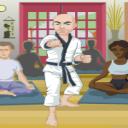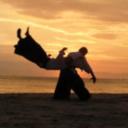Yahoo Answers is shutting down on May 4th, 2021 (Eastern Time) and beginning April 20th, 2021 (Eastern Time) the Yahoo Answers website will be in read-only mode. There will be no changes to other Yahoo properties or services, or your Yahoo account. You can find more information about the Yahoo Answers shutdown and how to download your data on this help page.
Trending News
Is Kenpo Circular or Linear?
I have been told both? Which is it?
5 Answers
- 1 decade agoFavorite Answer
Here is a detailed history of Kenpo for you that i have posted on my web site. Kenpo is both circular and linear!
What is the difference between Kenpo and Kempo?
Many ask this question and in actuallity there is no difference other than the lineages. The M was added later on when teachers such as Fred Villiari chained out and wanted to teach Kenpo but because it was his own system he made is Kempo. Others have done the same thing. BUT ALL share the same lineage.
is a term used to refer to a wide variety of martial arts, and is sometimes used as a blanket term for martial arts in general, especially in East Asia. The word kenpō is a Japanese translation of the Chinese word "quánfǎ", meaning "fist principles", "way of the fist," or "law of the fist form." This term is frequently transliterated as "kempo," as a result of attempting to use Traditional Hepburn romanization (which provides for use of the letter "m" when ん precedes a labial consonant such as "p"), but failing to use a macron to indicate the long vowel.
There is a faction of kenpō from Okinawa that has no American influences.This system is known as "Okinawa Kenpō" or "Ryūkyū Hon Kenpō". Hon means "original" and refers to the kenpō from the old Kingdom of Okinawa taught by Seikichi Odo (1926–2002). Odo operated the Shudokan Dojo in Gushikawa, Okinawa. Some of his senior students such as Richard Gonzales, Dennis Branchaud and Larry Gradolf established the art in the U.S. during the 1970s and 80s and continue to teach this old system in its original form. The style is built upon the karate of Shigeru Nakamura, a fellow student of Gichen Funakoshi under Anko Itosu. It preserves the old kenpō from China with the addition of several kata taught to Odo by Seiki Toma, a student of Choto Kyan. There are influences from the indigenous Okinawan art of Te and there is also a weapons component comprised of 11 different weapons. Odo's weapons art contains techniques from Shinpo Matayoshi, Seiko Kinjo, Shigeru Nakamura, and Seiki Toma.
Okinawan Kenpo is renowned for its unique sparring method called Bogu Kumite. Exponents spar with full contact using body armour that is similar to that worn by Kendo practitioners. The system is a blend of hard and soft (external and internal) arts and includes throws, heavy bag work, and makiwara practice. There is a strong emphasis on character development and maintaining a strict code of conduct.
American Kenpo or Kenpo Karate is a system of martial arts characterized by the use of quick moves in rapid-fire succession intended to overwhelm an opponent. It is largely marketed as a self-defense system, and is derived from traditional Southern Chinese kung fu and other martial arts found in the cultural melting pot of Hawaii. Parker introduced significant modifications in his art, including principles, theories, and concepts of motion as well as terminology, throughout his life. He left behind a large number of instructors who teach many different versions of American Kenpo.
Our Creed
"I come to you with only "KARATE" - empty hands. I have no weapons, but should I be forced to defend myself, my principles or my honor; should it be a matter of life or death, of right or wrong; then here are my weapons - "KARATE" - my empty hands."
- Ed Parker - March, 1957
Origins of American Kenpo
(Here is a NEW INTERESTING ARTICLE ON THE ORIGINS THAT MUST BE READ)
Once Parker had received his brown belt and decided to create his own "art", he decided to title it "American Kenpo" because the system was created on American soil. Although the word 'karate' was later less favored by Parker, the general public better understood that word than it understood 'Kenpo'. Continued efforts to shape the art into a distinct form led to replacing most Asian language terms with English terms. This also involved inventing entirely new principles to express ideas that had previously been encapsulated within traditional metaphors such as qi, but which Parker aimed to harmonize with Western principles and American culture.
Parker also heavily restructured American Kenpo's forms and techniques during this period. In many cases, he moved away from methods that were recognizably descended from another art (such as forms that were familiar within Hung Gar) and established a more definitive relationship between forms and the technique curriculum.
Ed Parker continued to grow. He experimented with the use of film and video as a training tool, leaving records of his work. In the final 4 years of his life Ed Parker Sr. put down the final version of his art, American Kenpo.
Evolution of American Kenpo
Although there were varying degrees of crossover from one evolving method to another, there were at least three clear and distinct philosophies or styles created by Ed Parker Sr.
Kenpo Karate
Ed Parker initially called his art Kenpo Karate. He opened the first commercial Kenpo Karate dojo in America, in Provo, Utah in 1954. He later opened another studio in Pasadena in 1956 and published a book of the same name in 1961.This has been characterized as having a very Japanese influence, including the use of linear and circular movements, "focused" techniques and jujutsu-style locks, holds, and throws.
Kenpo techniques were modifications to boxing techniques (Parker had learned from his father), judo techniques (learned in Hawaii), and lots of techniques from Chinese Systems (Two-Man Set, Dance of Death, Thundering Hammers, Sleeper e.g.). Use of linear and circular movements also came from Chinese systems: in Chinese systems the idea of circular motion was used to regain once energy: re-energizing important.
Chinese Kenpo
When Ed Parker embraced the Chinese Arts he began to refer to his art as Chinese Kenpo. Based on this influence he wrote Secrets of Chinese Karate, published in 1963,only very shortly after Kenpo Karate. The technical syllabus has recognizable similarities to Hung Gar, Choy Li Fut, and other Southern Chinese Martial arts, including two forms, Tiger-Crane and Panther (or "Book Set"), and one training practice ("Star Block") that can be traced back to Hung Gar. Which I also studied for two years in the mid 1990's.
American Kenpo
Parker began codifiying his early understandings of Chinese Kenpo into a distinct and evolving personal interpretation of the art. Here he dropped all Asian language elements and many traditions in favor of American English. During this period, he de-emphasized techniques and principles organized in the same manner as in Chinese and Japanese arts in favor of his own curriculum of forms and techniques. Parker took his art through continual changes. Parker always suggested that once a student learns the lesson embodied in the "ideal phase" of the technique he should search for some aspect that can be tailored to his own personal needs and strengths. Furthermore, Parker's students learned a different curriculum depending on when they studied with him. Some students preferred older material to newer material, wanted to maintain older material that Parker intended to replace, or wanted to supplement the kenpo they learned from a particular period with other martial arts training.
Well-known students of Ed Parker include Jeff Speakman and Elvis Presley.
Kenpo Belt Rankings
Within American Kenpo, there exists a basic belt system consisting of White, Yellow, Orange, Purple, Blue, Green, Brown (3 levels), and Black. Different organizations have different belt systems.
The black belt ranks are designated by half-inch red 'stripes' up to 4th degree, then a 5 inch 'strip' is for 5th. Thereafter, additional half-inch stripes are added up to 9th degree. For 10th degree, two 5 inch 'strips' separated by a half-inch space are used.
The striped system was adopted from Judo where the same system is used of 1 inch stripes, each 1 inch apart - where the first stripe (at end / bottom of belt) is 1/2 inch from the end / bottom of that belt. Also, female students wear knot of belt on right side, male students wear knot of belt on left side - this is taken from the Chinese systems were the same system is used. In these systems this was a way of showing respect to the instructor (who wore the belt with the knot located in the center / middle)
So now you have the answer to your question and much more too!! If you have any more questions about Kenpo feel free to email me on my profile.
Source(s): Shihan 30+ years exp - jamesf24Lv 61 decade ago
American or Chinese Kenpo is mostly circular, but both.
Okinawan Kempo is mostly linear, but both.
James
Source(s): 22 Years of Martial Arts & Fitness Experience. Kenpo Karate, Goju Karate, Kung Fu, Tae Kwon Do & Hapkido. Recently began training in Jiu-Jitsu/Pancrase (Ground Fighting) US Army Veteran. Traveled to Korea and Japan. Big UFC and MMA fan. I am also a Jedi Knight. :o) Big USA / MLS /EPL soccer fan. - bunminjutsuLv 51 decade ago
Both "circular defeats linear and linear defeats circular"the hard part is learning and mastering the when and the how and the why.
Most arts contain both types of defense and attack but kempo and silat and kali go into the most detail explanation wise.
- How do you think about the answers? You can sign in to vote the answer.
- ShamanLv 71 decade ago
Both.... Kenpo is open to using whatever line is appropriate to a situation.
It is situation specific in this regard.







